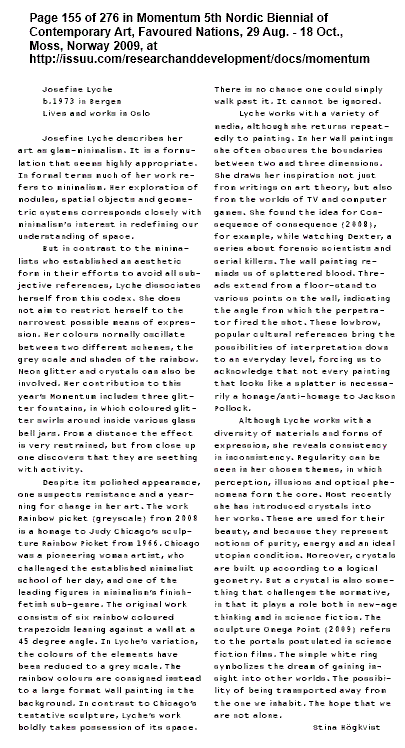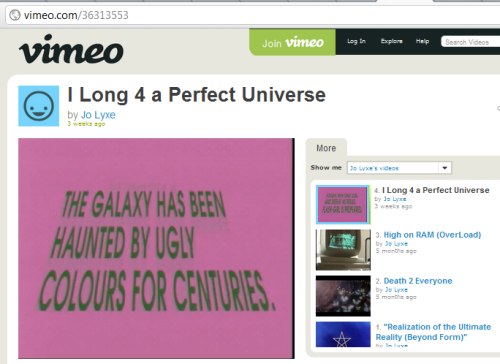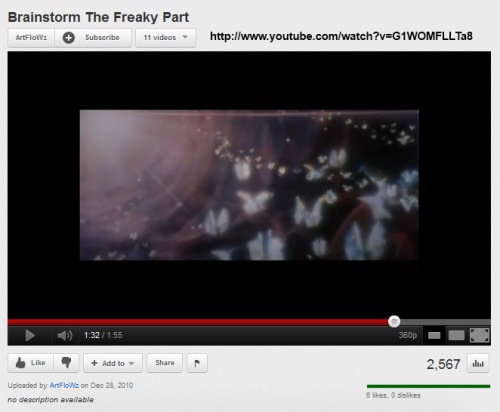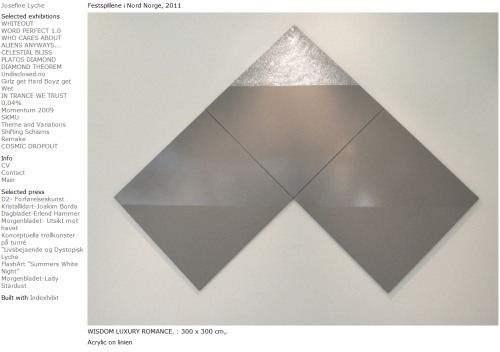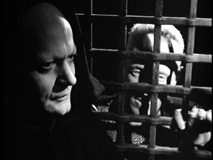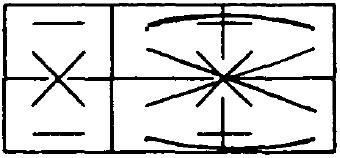Tuesday, August 11, 2015
Fountain Head …
Wednesday, July 29, 2015
Saturday, July 18, 2015
Self-Awareness
Robots pass "wise-men puzzle" to show a degree of self-awareness
New app … discourages self-awareness on social media —
"Self-awareness is a good thing.
Self-awareness is what tells us
'Hey, maybe just give us the highlights reel….'"
From this journal on July 13, Oslo artist Josefine Lyche —

Lyche's shirt honors the late Kurt Cobain.
"Here we are now, entertain us."



Dance scene from the 2015 film "Ex Machina"
Monday, July 13, 2015
Weaving World
(The title was suggested by the novel Weaveworld .)
Recent public selfie by Oslo artist Josefine Lyche —

Lyche's shirt honors the late Kurt Cobain.
Not-so-recent image of Hugo Weaving as
Agent Smith in "The Matrix" —

"Smells like teen spirit."
See also Weaving in the new film "Strangerland."
Wednesday, June 10, 2015
Welcome to Noplace
See an informative essay at noplace.no on the work of
Oslo artist Josefine Lyche in connection with her current
(June 12-21) exhibition, "Contact."
A paragraph from that essay —

See also Lyche in this journal.
Tuesday, May 26, 2015
From Our House to Bauhaus

Street view in Oslo, August 2014 (thanks to Google):
Vennligst benytt fortau pa andre siden =
Please use the sidewalk on the other side

Take a walk on the wild side… or not.
This post was suggested by a Log24 post, Gaze, of May 21, 2015, and by
an Instagram photo that Oslo artist Josefine Lyche posted today.
Sunday, April 26, 2015
Norwegian Woods
The title appears as a joint heading for three reviews
of Norway-related books on the front page of the print
version of today's New York Times Sunday Book Review .

See as well Josefine Lyche in this journal.
Saturday, February 21, 2015
High and Low Concepts
Steven Pressfield on April 25, 2012:
What exactly is High Concept?
Let’s start with its opposite, low concept.
Low concept stories are personal,
idiosyncratic, ambiguous, often European.
“Well, it’s a sensitive fable about a Swedish
sardine fisherman whose wife and daughter
find themselves conflicted over … ”
ZZZZZZZZ.
Fans of Oslo artist Josefine Lyche know she has
valiantly struggled to find a high-concept approach
to the diamond theorem. Any such approach must,
unfortunately, reckon with the following low
(i.e., not easily summarized) concept —
The Diamond Theorem Correlation:
From left to right …
http://www.log24.com/log/pix14B/140824-Diamond-Theorem-Correlation-1202w.jpg
http://www.log24.com/log/pix14B/140731-Diamond-Theorem-Correlation-747w.jpg
http://www.log24.com/log/pix14B/140824-Picturing_the_Smallest-1986.gif
http://www.log24.com/log/pix14B/140806-ProjPoints.gif
For some backstory, see ProjPoints.gif and "Symplectic Polarity" in this journal.
Wednesday, February 18, 2015
Magical and Seductive
"I am trying to introduce a narrative,
something magical and seductive…."
— Oslo artist Josefine Lyche, translated
from the Norwegian by Google
Perhaps something like Arcade Fire or
Taylor Swift? (Click links for related posts.)
Tuesday, February 17, 2015
Fire and Ice
Or: Debriefing Josefine
From the CV of Oslo artist Josefine Lyche:
Selected Collections/ Public Commissions:
2016 Jarfjord Grensevaktstasjon,
Jarfjord/Kirkenes, NO (upcoming)
From an Amazon.com customer review of a book on
northern Norway in World War II, Fire and Ice —
"… Hunt doesn't take sides. He approaches
the story as a journalist and documentary maker,
rather than as an academic."
The book, as the author notes, was published in Britain
on October 6, 2014.
A synchronicity check of the publication date yields
a variation on the "Fire and Ice" theme —
"Jeg prøver å innføre et narrativ, noe magisk og forførende,
samt erstatte den iboende materialistiske logikken med
esoterisk kosmologi og symbolikk." — Josefine Lyche
Wednesday, January 7, 2015
Gitterkrieg
(Continued from Jan. 3 and Jan. 5.)
Introduction: "Grids, You Say?" by Josefine Lyche,
and AntiChristmas 2010:

Related material:
Chapter 42 in
A History of Graphic Design ,
by Guity Novin.
Midrash on Hexagram 22
See Instantia Crucis and Josefine Lyche's
One-Night-Only exhibition in Oslo Jan. 5.
Tuesday, December 30, 2014
Core
JOSEFINE LYCHE
ABSOLUTE ALT. VOL. 2
17. april – 23. mai [2015] —
"I kjernen av mitt arbeid er en pågående
utforskning av esoteriske konsepter…."
"At the core of my work is an ongoing
exploration of esoteric concepts…."
See also
http://issuu.com/tmrk/docs/spritenkunsthall_2015_cut .
Related material: Hard Core.
Thursday, December 4, 2014
Follow This
The "Phony Pony" images below by Josefine Lyche
may or may not have been created in response to the link
on "magic" in the previous post to Katy Perry's "Dark Horse" video.

Wednesday, December 3, 2014
Pyramid Dance
Oslo artist Josefine Lyche has a new Instagram post,
this time on pyramids (the monumental kind).
My response —
Wikipedia's definition of a tetrahedron as a
"triangle-based pyramid" …
… and remarks from a Log24 post of August 14, 2013 :
|
Norway dance (as interpreted by an American)
I prefer a different, Norwegian, interpretation of "the dance of four."
Related material: |
See also some of Burkard Polster's triangle-based pyramids
and a 1983 triangle-based pyramid in a paper that Polster cites —
(Click image below to enlarge.)
Some other illustrations that are particularly relevant
for Lyche, an enthusiast of magic :
From On Art and Magic (May 5, 2011) —
|
|
(Updated at about 7 PM ET on Dec. 3.)
Saturday, October 11, 2014
Selfie Sequel
This post is a sequel to Pythagorean Selfie (Sept. 30, 2014)
and October Nine: Lyche at Bodø.
Today’s Instagram photos from Josefine Lyche, still at Bodø:

The figure at left appears to be diving. This suggests a review of posts on
the late film director Tony Scott.
Friday, October 10, 2014
High White Noon
(The phrase is from Don DeLillo and Josefine Lyche.)
See “Complex Grid.”
See as well Bill O’Reilly’s remark, “Do not be a coxcomb,”
and an artist‘s self-portrait:

Grid Designer
Monday, October 6, 2014
Arcs and Shards
Ben Brantley in The New York Times today on a Broadway opening:
“As Christopher navigates his way through an increasingly
unfamiliar landscape, both physical and emotional, the arcs
of his adventures are drawn into being.
So are the shards of sensory overload.”
Arc — See a search for Line at Infinity:

Shard — See Shard and Pythagorean Selfie:

Wednesday, October 1, 2014
Good Question
Mathematics for Tromsø
Loren Olson, Harvard ’64, a professor of mathematics
at Norway’s Tromsø University,* died June 22, 2014.
In his memory, a search in this journal for Lie Group.
That search yields a post titled Lie Groups for Holy Week (March 30, 2010).
A quotation related to that post:

* The city of Tromsø hosted some art related to group theory in 2010.
Neither that art nor my own related remarks on group theory are very
relevant to physics (yet).
Tuesday, September 30, 2014
Pythagorean Selfie
“Rarely is a TV show as brilliant and as terrible as Selfie .”
— Kevin Fallon on a new ABC TV show that starts tonight at 8 PM ET
A recent selfie from Josefine Lyche’s Instagram page:

For some remarks related to Lyche’s pentagram, see
Lyche + Mathmagic* and also yesterday’s Michaelmas Mystery.
In today’s previous post, the late Harvey Cohn posed a question that
he said might have been asked by Pythagoras:
“It is an elementary observation that an integral right triangle
has an even area. Suppose the hypotenuse is prime.
Q. How do we determine from the prime value of the hypotenuse
when the area is divisible by 4, 8, 16, or any higher power of 2?
A. We use class fields constructed by means of transcendental
functions, of course!”
— From the preface to Introduction to the Construction of Class Fields ,
by Harvey Cohn (Cambridge University Press, 1985)
Illustration:

For a related song, see Prime Suspect (Dec. 13, 2007).
Footnote of 12:14 AM Oct. 1, 2014 —
* That search yields a link to…
This Lyche webpage’s pentagram indicates an interest in Disney rather than
in Satanism. Other Lyche webpages have been less reassuring.
Related material — Posts tagged Elegantly Packaged.
Thursday, September 25, 2014
Theology and Art
Wednesday, September 24, 2014
Oslo, 5 A.M.*
Friday, September 19, 2014
Song of Praise
“Robust and compact, conforming to international standards,
the Altivar 08 is a universal product.”
Thursday, September 11, 2014
Thursday, August 14, 2014
Bottom Line
“. . . the bottom line of the grid is a naked and determined materialism.”
— Rosalind Krauss, quoted by Josefine Lyche
See also http://www.dailymotion.com/video/
x164rmi_britt-ekland-nude-wicker-man-1973_people.
Monday, August 4, 2014
The Omega Portal
Version from "The Avengers" (2012) —
Version from Josefine Lyche (2009) —
See also this journal on the date that the above Avengers video was uploaded.
Thursday, July 10, 2014
Emperor
“Paradigm Talent Agency are supporting with casting.
Emperor is described as a look at a debauched world
of wealth, sex, manipulation and treason.”
— The Hollywood Reporter : “Cannes: Adrien Brody
to play Charles V in Lee Tamahori‘s ‘Emperor,'”
2:54 AM PST May 19, 2014, by Scott Roxborough
Related material from Santa Cruz, California:
“On or about or between 11/22/2013 and 11/24/2013….”
Related material from this journal:
“Fiction,” a post of St. Cecilia’s Day, 11/22/2013.
See, too, yesterday’s noon post “Nowhere” and
the April 27-28, 2013, posts tagged Around the Clock.
Sunday, June 15, 2014
Aaron Eckhart Strikes Deep
“Even paranoids have real enemies.”
— Attributed to Delmore Schwartz
“There is a difference as to whether you are describing paranoia
or whether you in fact are paranoid yourself.”
— The late Frank Schirrmacher, dw.de , July 2, 2013.
Schirrmacher reportedly died on Thursday, June 12, 2014.
See that date in this journal.
Paranoia is, of course, a fertile field for politicians and filmmakers:
Related material in this journal:
I, Frankenstein (May 15, 2014) and, for the Eckhart film “Erased,”
Hour of the Wolf (Nov. 9, 2006).
Thursday, May 15, 2014
Moonshine
“The yarns of seamen have a direct simplicity, the whole meaning
of which lies within the shell of a cracked nut. But Marlow was not
typical (if his propensity to spin yarns be excepted), and to him the
meaning of an episode was not inside like a kernel but outside,
enveloping the tale which brought it out only as a glow brings out a
haze, in the likeness of one of these misty halos that sometimes
are made visible by the spectral illumination of moonshine.”
— Joseph Conrad in Heart of Darkness
Photo of full moon over Oslo last night by Josefine Lyche:

A scene from my film viewing last night:

Some background (click to enlarge):
Note:
The “I, Frankenstein” scene above should not be interpreted as
a carrying of Martin Gardner through a lyche gate. Gardner
is, rather, symbolized by the asterisk in the first image from
the above Google search.
Wednesday, May 14, 2014
Death in Mathmagic Land
"It was our old friend Pythagoras who discovered
that the pentagram was full of mathematics."
— Narrator, "Donald in Mathmagic Land," Disney, 1959
… and it was Peter J. Cameron who discovered that
mathematics was full of pentagrams.
From Log24 on May 3: Gray Space —
Robert J. Stewart (left) and a pentagram photo posted May 2
by Oslo artist Josefine Lyche. See also Lyche in this journal.
From Log24 on May 13: An Artist's Memorial —
The death mentioned in the above May 13 post occurred on
May 12, the date of a scheduled Black Mass at Harvard.
Related material:


Two -Year College
See last night’s pentagram photo and a post from May 13, 2012.
That post links to a little-known video of a 1972 film.
A speech from the film was used by Oslo artist Josefine Lyche as a
voice-over in her 2011 golden-ratio video (with pentagrams) that she
exhibited along with a large, wall-filling copy of some of my own work.
The speech (see video below) is clearly nonsense.
The patterns* Lyche copied are not.
“Who are you, anyway?”
— Question at 00:41 of 15:00, Rainbow Bridge (Part 5 of 9)
at YouTube, addressed to Baron Bingen as “Mr. Rabbit”
* Patterns exhibited again later, apparently without the Lyche pentagram video.
It turns out, by the way, that Lyche created that video by superimposing
audio from the above “Rainbow Bridge” film onto a section of Disney’s 1959
“Donald in Mathmagic Land” (see 7:17 to 8:57 of the 27:33 Disney video).
Tuesday, May 13, 2014
Clay
The title is that of a short story in Dubliners , by James Joyce.
See in that story the phrase “Grey-green eyes.”
See also the tag #greygreengrids on an Oslo artist’s photo today.
Tuesday, May 6, 2014
Fictions
From The Ninth Element website:

Cover of a Norwegian author’s forthcoming novel:
For some Norwegian non-fiction, see an Oslo artist’s Instagram page.
Saturday, May 3, 2014
Gray Space
Or: Three Shades of Gray
(Continued from previous Gray Space posts.)
Click the above image for some related mathematics.
Those who prefer “magic” approaches to mathematics*
may consult the works of Robert J. Stewart and his
mentor William G. Gray.
Robert J. Stewart (left) and a pentagram photo posted yesterday evening
by Oslo artist Josefine Lyche. See also Lyche in this journal.
* See the April 2014 banners displayed at the websites
of the American Mathematical Society and of the
Mathematical Association of America, as well as
a mathematician’s remarks linked to here last evening.
Friday, May 2, 2014
From the Witch Ball
See also, in this journal, Arcade Fire and Witch Ball.
This post was suggested by remarks today of mathematician
Peter J. Cameron, who seems to enjoy playing the role of
Lord Summerisle (from The Wicker Man , a 1973 horror classic).
Wednesday, April 30, 2014
Review
Some background for a recent photo
by Josefine Lyche:
The Boys from Uruguay and Witch Ball.
The photo:
Saturday, April 26, 2014
Friday, April 25, 2014
Sunday, March 30, 2014
Josefine’s Sunday School
Two timely images for Oslo artist Josefine Lyche —
Backstory: Searches for “Blazing World” and for “Josefine + Lyche + Pink”
in this journal.
The image above is by a man, Brian Stauffer. Related material:
An image from today’s NY Times Sunday Book Review —
This image is by a non-man, Kelsey Dake.
The first image above, since it combines Lyche’s enthusiasm for the color
pink and (apparently) for fishnet stockings, seems to me the better picture,
despite its prurient nature.
(Updated through 10 AM ET)
Friday, March 28, 2014
Blazing Thule
The title is suggested by a new novel (see cover below),
and by an unwritten book by Nabokov —
Related material:
- An artists' book scheduled to be released on March 21, 2014
- A piece by Josefine Lyche in the artists' book
- The original by Borges on which Lyche's piece was based
-
A solar image from a March 13 post echoing
that on the Blazing World cover above - A Tune for Josefine
- The circular blazing image from last midnight's post Symbol
-
From March 21, the scheduled date of the Oslo
artists' book release, some remarks on the mathematics of the
Golay code, "Three Constructions of the Miracle Octad Generator" - Backstory: Duelle in this journal.
Symbol
For Josefine Lyche, by fellow artist Nuno Borges:

Related material:
Recent remarks by Lyche and
a recurring image from this journal.
Monday, March 17, 2014
Her
“The name Siri is Norwegian, meaning
‘beautiful woman who leads you to victory.'”
I prefer Josefine.
Saturday, March 1, 2014
HaShem

From New World Encyclopedia —

See also Tetragrammaton in this journal.
For further context, see Solomon's Cube and Oct. 16, 2013.
Tuesday, February 18, 2014
Proofs
For Oslo artist Josefine Lyche, who sometimes
seems to think my work resembles that of the
deranged Anthony Hopkins in the film of David
Auburn's play "Proof."
See another artist's images of Hopkins-like work
I just discovered online —
"The Proof," by David Colosi.
Friday, February 14, 2014
Epiphany
“… the object sets up a kind of
frame or space or field
within which there can be epiphany.”

Related material —
Star Wars (January 11, 2014),
The Lyche Gate Asterisk , from 10:31 AM ET on May 22, 2010,
the date of Martin Gardner's death —
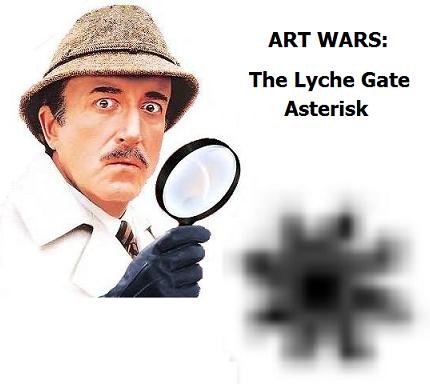
— and the March 2014 issue of the
Notices of the American Mathematical Society —
See as well Epiphany 2014 (Jan. 6) in this journal and the
March Notices on the Shaw prize —
"Established under the auspices of Run Run Shaw
in November 2002, the prize is managed and
administered by the Shaw Prize Foundation
based in Hong Kong."
Tuesday, February 4, 2014
Friday, January 31, 2014
Diamond Star
From The Diamond and the Star , by John Warden*
(London, Shepheard-Walwyn Ltd., June 1, 2009) —
(The quotation is from Kipling's "The Conundrum of the Workshops.")
Answer — Some would say "Yes."
Part I: From a search for "Diamond Star" in this journal —
The Diamond Star

Part II: From the Facebook photos of Oslo artist Josefine Lyche—
* Obituary link, added at 10:45 PM ET Jan. 31 after reading a publisher's note
saying that "The author sadly died before the book was published."
Perhaps sadly, perhaps not.
Thursday, December 19, 2013
Review
For Josefine Lyche, artist of High White Noon —
Thursday, October 10, 2013
|
Monday, November 25, 2013
A Tune for Josefine*
From the New York Times obituary of philanthropist
Fred Kavli, who died on Thursday, November 21—
” In 2005, when Mr. Kavli announced that
he planned to start the prizes, he recalled
skiing in the Norwegian mountains as a boy.
‘At times,’ he told a gathering in New York,
‘the whole sky was aflame with the Northern Lights
shifting and dancing across the sky down to the
white-clad mountaintops. In the stillness and
loneliness of the white mountains, I pondered the
universe, the planet, nature and the wonders of
man. I’m still pondering.’ “
“And we may see the meadow in December, icy white
and crystalline….” — Johnny Mercer, lyrics to Lionel
Hampton and Sonny Burke’s “Midnight Sun”
* Lyche
Wednesday, October 16, 2013
Theme and Variations
Josefine Lyche’s large wall version of the twenty-four 2×2 variations
above was apparently offered for sale today in Norway —
Click image for more details and click here for a translation.
Wednesday, October 9, 2013
To Apollo*
Sunday, October 6, 2013
Sermon
A sequel to last night's "For Baron Samedi" —
Sigils
The music in the trailer for the new film "American Hustle"
is a 1969 tune by Led Zeppelin. This, together with the
magick sigils posted at Facebook yesterday by artist
Josefine Lyche, suggests a review of Zeppelin sigils
from a 1971 album. These are, as shown above on a
record label, the personal symbols of the four musicians
in the band. Two of the symbols may, of course, be
interpreted as representing the Holy Trinity.
Saturday, October 5, 2013
For Baron Samedi
Click on the image for a video.
See also Josefine Lyche's "Grids, you say?"
I prefer Lyche's versions of the diagonal
3×3 grid. Her versions have no lettering.
(This post was suggested by a photo of magical sigils
that Lyche posted a few hours ago at Facebook.
The above seems to be another such sigil that may
or may not be intended to function like those posted
today by Lyche.)
Tuesday, October 1, 2013
Frame Tale
From an academic's website:
For Josefine Lyche and Ignotus the Mage,
as well as Rose the Hat and other Zingari shoolerim —
Sabbatha hanti, lodsam hanti, cahanna risone hanti :
words that had been old when the True Knot moved
across Europe in wagons, selling peat turves and trinkets.
They had probably been old when Babylon was young.
The girl was powerful, but the True was all-powerful,
and Rose anticipated no real problem.
— King, Stephen (2013-09-24).
Doctor Sleep: A Novel
(pp. 278-279). Scribner. Kindle Edition.
From a post of November 10, 2008:

Twenty-four Variations on a Theme of Plato,
a version by Barry Sharples based on the earlier
kaleidoscope puzzle version of Steven H. Cullinane
"The king asked, in compensation for his toils
during this strangest of all the nights he had
ever known, that the twenty-four riddle tales
told him by the specter, together with the story
of the night itself, should be made known
over the whole earth and remain eternally
famous among men."
Frame Tale:
"The quad gospellers may own the targum
but any of the Zingari shoolerim may pick a peck
of kindlings yet from the sack of auld hensyne."
Monday, September 30, 2013
A Line for Frank
(Continued from High White Noon,
Finishing Up at Noon, and A New York Jew.)

Above: Frank Langella in "Starting Out in the Evening"
Below: Frank Langella and Johnny Depp in "The Ninth Gate"

"Not by the hair on your chinny-chin-chin."
Above: Detail from a Wikipedia photo.
For the logo, see Lostpedia.
For some backstory, see Noether.
Those seeking an escape from the eightfold nightmare
represented by the Dharma logo above may consult
the remarks of Heisenberg (the real one, not the
Breaking Bad version) to the Bavarian Academy
of Fine Arts.
Those who prefer Plato's cave to his geometry are
free to continue their Morphean adventures.
Sunday, September 29, 2013
Church with Josefine
Today, beginning at about 11 AM ET, I checked out
the latest news from Oslo artist Josefine Lyche,
often mentioned in these posts.
Lyche's Facebook page has a new cover photo—
geometric diagrams from Order in Space , a 1969
book by Keith Critchlow.
A search for more information on Critchlow yielded
information on his friend the impressive Kathleen Raine,
who reportedly died at 95 on July 6, 2003.
See also references to that date in this journal.
From Raine's obituary in The Guardian :
"When asked how she wished people
to remember her, Kathleen Raine said
she would rather they didn't. Or that
Blake's words be said of her: 'That in
time of trouble, I kept the divine vision.' "
Monday, September 9, 2013
Viking Book
For the late Billy Wilder, director of Ace in the Hole (1951)
Click image for a larger version.
See, too, this morning's quarter-to-three post, and The Vikings (1958)—

The art by Josefine Lyche in the Bodin book shown
above is, as the artist notes, based on my own work.
Wednesday, August 28, 2013
Noir sur Blanc
Some backstory for this post's title—
A post from the day of Mrozek's death may also be relevant—
Wednesday, August 14, 2013
ART WARS
(Continued from 24 hours ago and from May 9, 2012)
Quoted 24 hours ago in this journal—
Remark by Aldous Huxley on an artist's work:
"All the turmoil, all the emotions of the scenes
have been digested by the mind into a
grave intellectual whole."
Quoted in a video uploaded on May 9, 2012:
Norway Toilet Scene

Norway dance (as interpreted by an American)

I prefer a different, Norwegian, interpretation of "the dance of four."
Related material: The clash between square and tetrahedral versions of PG(3,2).
Tuesday, August 13, 2013
Plan 9
(Continued from August 28 last year)
Backstory—
Reflections from today's date, August 13, in 2003, that included
the following remark by Aldous Huxley on an artist's work:
"All the turmoil, all the emotions of the scenes
have been digested by the mind into a
grave intellectual whole. It is as though
Bach had written the 1812 Overture."
Related art—
Josefine Lyche, from her 2013 Crackquarelle series:

Steven H. Cullinane, The Story of N ,
from The Misalignment of Mars and Venus series:

See, too, previous posts on The Story of N.
Sunday, July 21, 2013
Comic-Con
This is the weekend for Comic-Con International in San Diego.
The convention includes an art show. (Click above image to enlarge.)
Related material from Norway…
Suggested nominations for a Kavli Prize:
1. Josefine Lyche's highly imaginative catalog page for
the current Norwegian art exhibition I de lange nætter,
which mentions her interest in sacred geometry
2. Sacred Geometry: Drawing a Metatron Cube
… and from San Diego—
The Kavli Institutes logo:

Wednesday, July 10, 2013
Diagon Alley
You say goodbye, I say …
A YouTube video uploaded on March 2, 2012—
This journal on the date of the above video's uploading— March 2, 2012:
"…des carreaux mi-partis de deux couleurs par une ligne diagonale…."
See also Josefine Lyche in Vril Chick and Bowling in Diagon Alley.
Tuesday, July 9, 2013
Vril Chick
Profile picture of "Jo Lyxe" (Josefine Lyche) at Vimeo—

Compare to an image of Vril muse Maria Orsitsch.
From the catalog of a current art exhibition
(25 May – 31 August, 2013) in Norway,
I DE LANGE NÆTTER —
|
Josefine Lyche
Keywords (to help place my artwork in the (See also the original catalog page.) |
Clearly most of this (the non-highlighted parts) was taken
from my webpage Diamond Theory. I suppose I should be
flattered, but I am not thrilled to be associated with the
(apparently fictional) Vril Society.
For some background, see (for instance)
Conspiracy Theories and Secret Societies for Dummies .
Sunday, June 23, 2013
Random Dudes
Here is the link to an MIT Scratch project from the above comment.
See also a comment by a Random Norwegian Dude:

For related art, see
"4D AMBASSADOR (HYPERCUBE)" for Steven H. Cullinane
by the Norwegian artist Josefine Lyche.
Sunday, April 28, 2013
Red October’s Sermon
… For the Harvard Arts Weekend:
"Grids, You Say?" by Josefine Lyche, with
Lyche's quotation from Rosalind Krauss in October
(Vol. 9, Summer 1979) —
 |
See also last evening's Elevation of the Host, with Vampire Weekend.
"For every kind of vampire, there is a kind of cross." — Gravity's Rainbow
Friday, April 26, 2013
Review
The Oslo Version and The Lyche Omega
Those who prefer more traditional art
may consult The Portal Project.
Tuesday, March 12, 2013
Smoke and Mirrors
Sistine Chapel Smoke
Tromso Kunsthall Mirrors
Background for the smoke image:
A remark by Michelangelo in a 2007 post, High Concept.
Background for the mirrors image:
Note the publication date— Mar. 10, 2013.
Friday, November 9, 2012
Norway High Chair
This post was suggested by today's previous post,
"Bali High Chair," that links to an empty chair award for
evangelical supporters of Mitt Romney, by Bauhaus style,
and by the example of Norwegian design shown below—
(Happy Frigg's Day to Josefine Lyche.)
Wednesday, October 24, 2012
Love Ghost
Every Love Story Is a Ghost Story
is the title of an August 30, 2012, biography
of the late author David Foster Wallace.
(See a Guardian review.)
For example…
The Lovely Bones, Telemark, and Behind the Green Door.
“I have to break in my new suit
and limber up my muscles somehow,”
said Penny defensively. “One can’t
practice outdoors when there’s no snow.
Now watch this one, Mrs. Weems.
It’s called a telemark.”
Friday, October 19, 2012
Inconvenient Art
Barry Schwabsky in The Nation on October 16, 2012:
"… sculpture is the most inconvenient of the fine arts.
Tedious physical labor is often involved in its making—
not necessarily the artist’s, but still, someone’s."
Happy Frigg's Day to Josefine Lyche.
Tuesday, September 25, 2012
High White in the Dark Fields
"High white noon"
— Phrase of Don DeLillo and Josefine Lyche
"Spellbinding visuals dwarf weak characters."
— Fox News review of Snow White and the Huntsman
For some stronger characters, see Limitless , a 2011 film
based on a 2001 novel by Alan Glynn, The Dark Fields .
See also St. Andrew's Day 2011 in this journal.
Sunday, September 23, 2012
Plan 9 (continued)–
In Like Flynn
From the Wall Street Journal site Friday evening—
| ESSAY September 21, 2012, 9:10 p.m. ET
Are We Really Getting Smarter? Americans’ IQ scores have risen steadily over the past century.
|
No, thank you. I prefer the ninth configuration as is—

Why? See Josefine Lyche’s art installation “Grids, you say?“
Her reference there to “High White Noon” is perhaps
related to the use of that phrase in this journal.
The phrase is from a 2010 novel by Don DeLillo.
See “Point Omega,” as well as Lyche’s “Omega Point,”
in this journal.
The Wall Street Journal author above, James R. Flynn (born in 1934),
“is famous for his discovery of the Flynn effect, the continued
year-after-year increase of IQ scores in all parts of the world.”
—Wikipedia
His son Eugene Victor Flynn is a mathematician, co-author
of the following chapter on the Kummer surface— 
For use of the Kummer surface in Buddhist metaphysics, see last night’s
post “Occupy Space (continued)” and the letters of Nanavira Thera from the
late 1950s at nanavira.blogspot.com.
These letters, together with Lyche’s use of the phrase “high white noon,”
suggest a further quotation—
You know that it would be untrue
You know that I would be a liar
If I was to say to you
Girl, we couldn’t get much higher
See also the Kummer surface at the web page Configurations and Squares.
Tuesday, September 18, 2012
Friday, June 29, 2012
Highgate
Part of the Andrew Amesbury series Archway to Highgate.
* See Lyche gate in this journal.
Happy feast of Saints Peter and Paul.
Friday, June 22, 2012
Bowling in Diagon Alley

Josefine Lyche bowling (Facebook, June 12, 2012)
A professor of philosophy in 1984 on Socrates's geometric proof in Plato's Meno dialogue—
"These recondite issues matter because theories about mathematics have had a big place in Western philosophy. All kinds of outlandish doctrines have tried to explain the nature of mathematical knowledge. Socrates set the ball rolling…."
— Ian Hacking in The New York Review of Books , Feb. 16, 1984
The same professor introducing a new edition of Kuhn's Structure of Scientific Revolutions—
"Paradigms Regained" (Los Angeles Review of Books , April 18, 2012)—
"That is the structure of scientific revolutions: normal science with a paradigm and a dedication to solving puzzles; followed by serious anomalies, which lead to a crisis; and finally resolution of the crisis by a new paradigm. Another famous word does not occur in the section titles: incommensurability. This is the idea that, in the course of a revolution and paradigm shift, the new ideas and assertions cannot be strictly compared to the old ones."
The Meno proof involves inscribing diagonals in squares. It is therefore related, albeit indirectly, to the classic Greek discovery that the diagonals of a square are incommensurable with its sides. Hence the following discussion of incommensurability seems relevant.
See also von Fritz and incommensurability in The New York Times (March 8, 2011).
For mathematical remarks related to the 10-dot triangular array of von Fritz, diagonals, and bowling, see this journal on Nov. 8, 2011— "Stoned."
Monday, May 21, 2012
Child’s Play (continued*)
we are just like a couple of tots…
— Sinatra
Born 1973 in Bergen. Lives and works in Oslo.
Education
2000 – 2004 National Academy of Fine Arts, Oslo
1998 – 2000 Strykejernet Art School, Oslo, NO
1995 – 1998 Philosophy, University of Bergen
University of Bergen—
|
It might therefore seem that the idea of digital and analogical systems as rival fundaments to human experience is a new suggestion and, like digital technology, very modern. In fact, however, the idea is as old as philosophy itself (and may be much older). In his Sophist, Plato sets out the following ‘battle’ over the question of ‘true reality’: What we shall see is something like a battle of gods and giants going on between them over their quarrel about reality [γιγαντομαχία περì της ουσίας] ….One party is trying to drag everything down to earth out of heaven and the unseen, literally grasping rocks and trees in their hands, for they lay hold upon every stock and stone and strenuously affirm that real existence belongs only to that which can be handled and offers resistance to the touch. They define reality as the same thing as body, and as soon as one of the opposite party asserts that anything without a body is real, they are utterly contemptuous and will not listen to another word. (…) Their adversaries are very wary in defending their position somewhere in the heights of the unseen, maintaining with all their force that true reality [την αληθινήν ουσίαν] consists in certain intelligible and bodiless forms. In the clash of argument they shatter and pulverize those bodies which their opponents wield, and what those others allege to be true reality they call, not real being, but a sort of moving process of becoming. On this issue an interminable battle is always going on between the two camps [εν μέσω δε περι ταυτα απλετος αμφοτέρων μάχη τις (…) αει συνέστηκεν]. (…) It seems that only one course is open to the philosopher who values knowledge and truth above all else. He must refuse to accept from the champions of the forms the doctrine that all reality is changeless [and exclusively immaterial], and he must turn a deaf ear to the other party who represent reality as everywhere changing [and as only material]. Like a child begging for 'both', he must declare that reality or the sum of things is both at once [το όν τε και το παν συναμφότερα] (Sophist 246a-249d). The gods and the giants in Plato’s battle present two varieties of the analog position. Each believes that ‘true reality’ is singular, that "real existence belongs only to" one side or other of competing possibilities. For them, difference and complexity are secondary and, as secondary, deficient in respect to truth, reality and being (την αληθινήν ουσίαν, το όν τε και το παν). Difference and complexity are therefore matters of "interminable battle" whose intended end for each is, and must be (given their shared analogical logic), only to eradicate the other. The philosophical child, by contrast, holds to ‘both’ and therefore represents the digital position where the differentiated two yet belong originally together. Here difference, complexity and systematicity are primary and exemplary. It is an unfailing mark of the greatest thinkers of the tradition, like Plato, that they recognize the digital possibility and therefore recognize the principal difference of it from analog possibilities.
— Cameron McEwen, "The Digital Wittgenstein," |
* See that phrase in this journal.
Sunday, May 13, 2012
Children of Light*
An earlier verse in 1 John—
1 John 1:5 "This then is the message
which we have heard of him,
and declare unto you, that God is light,
and in him is no darkness at all."
Catechism from a different cult—
"Who are you, anyway?"
— Question at 00:41 of 15:01,
Rainbow Bridge (Part 5 of 9) at YouTube
See also the video accompanying artist Josefine Lyche's version
of the 2×2 case of the diamond theorem.
* Title of a Robert Stone novel
Friday, May 11, 2012
Friday, April 27, 2012
References
"These lowbrow, popular cultural references bring the possibilities
of interpretation down to an everyday level, forcing us to acknowledge
that not every painting that looks like a splatter is necessarily a
homage/anti-homage to Jackson Pollock."
— Stina Högqvist, review of the art of Josefine Lyche
Thursday, April 26, 2012
Rainbow Bridge for Thor’s Day
Monday, March 26, 2012
Smackdown!
(The title is a nod to Peter Woit's recent post "Nothingness Smackdown.")
"To wrestle new mediums to the mat of specificity has been a preoccupation of mine since the inception of October , the magazine I founded in 1976 with Annette Michelson, the first issue of which carried my essay 'Video and Narcissism' which attempts to tie the essence of video to the spectacular nature of mirrors."
— Rosalind Krauss, 2008, introduction to Perpetual Inventory (MIT Press, 2010)
Related material— The video art and mirror art of Josefine Lyche.
See also Krauss's essay on video in Perpetual Inventory— "Video: The Aesthetics of Narcissism" (first published as "Video and Narcissism," October , no. 1 (Spring 1976))—
"In The Language of the Self , Lacan begins by characterizing the space of the therapeutic transaction as an extraordinary void created by the silence of the analyst. Into this void the patient projects the monologue of his own recitation, which Lacan calls 'the monumental construct of his narcissism.'"
— and related remarks on October and the void quoted here March 10 in "Boo Boo Boo."
Monday, March 5, 2012
For the Nine Muses
From "The Talented," a post of April 26, 2011—

And for Josefine Lyche—
Unity in Multiplicity —

Pink in Wikipedia
Sunday, March 4, 2012
The Haunted Galaxy
(Continued from Big Art , 1 PM EST yesterday)
In related news…
Ralph McQuarrie, who designed the Star Wars trilogy, died yesterday.
See also Haunting Time.
Saturday, March 3, 2012
Big Art
For Women's History Month—
The Beam of Pink Light
From a post linked to on Lyxe's upload date, Feb. 6, 2012—
“… with primitives the beginnings of art, science, and religion
coalesce in the undifferentiated chaos of the magical mentality….”
— Carl G. Jung, “On the Relation of Analytical Psychology to Poetry,”
Collected Works, Vol. 15, The Spirit in Man, Art, and Literature,
Princeton University Press, 1966, excerpted in
Twentieth Century Theories of Art, edited by James M. Thompson.
See also the NY Lottery for St. Luke's Day, 2011, publication date
of the new edition of Philip K. Dick's VALIS quoted above.
Saturday, February 11, 2012
Grids
See Notes for a Haiku.
Related material—
A novel published on Groundhog Day, 2010—
— as well as Conceptual Art, Josefine Lyche's
"Grids, You Say?" and The Speed of Thought.
Saturday, January 7, 2012
Thursday, December 22, 2011
The Speed of Thought
"As if an apparently meaningless frame of reference,
traveling at the speed of thought, suddenly became relevant…."
— Stephen Rachman, "Lost in Translation"
Unclean Frame—

Detail from the film "Sunshine Cleaning"
Clean Frame—

See also Psychic Art and "The Speed of Thought."
For another form of psychic art, see Game of Shadows.
Monday, December 5, 2011
The Shining (Norwegian Version)
A check tonight of Norwegian artist Josefine Lyche's recent activities
shows she has added a video to her web page that has for some time
contained a wall piece based on the 2×2 case of the diamond theorem —
The video (top left in screenshot above) is a tasteless New-Age discourse
that sounds frighteningly like the teachings of the late Heaven's Gate cult.
Investigating the source of the video on vimeo.com, I found the account of one "Jo Lyxe,"
who joined vimeo in September 2011. This is apparently a variant of Josefine Lyche's name.
The account has three videos—
- "High on RAM (OverLoad)"– Fluid running through a computer's innards
- "Death 2 Everyone"– A mystic vision of the afterlife
- "Realization of the Ultimate Reality (Beyond Form)"– The Blue Star video above
Lyche has elsewhere discussed her New-Age interests, so the contents of the videos
were not too surprising… except for one thing. Vimeo.com states that all three videos
were uploaded "2 months ago"— apparently when "Lyxe" first set up an account.*
I do not know, or particularly care, where she got the Blue Star video, but the other
videos interested me considerably when I found them tonight… since they are
drawn from films I discussed in this journal much more recently than "2 months ago."
"High on RAM (OverLoad)" is taken from the 1984 film "Electric Dreams" that I came across
and discussed here yesterday afternoon, well before re-encountering it again tonight.
And "Death 2 Everyone" (whose title** is perhaps a philosophical statement about inevitable mortality
rather than a mad terrorist curse) is taken from the 1983 Natalie Wood film "Brainstorm."
"Brainstorm" was also discussed here recently… on November 18th, in a post suggested by the
reopening of the investigation into Wood's death.
I had no inkling that these "Jo Lyxe" videos existed until tonight.
The overlapping content of Lyche's mental ramblings and my own seems rather surprising.
Perhaps it is a Norwegian mind-meld, perhaps just a coincidence of interests.
* Update: Google searches by the titles on Dec. 5 show that all three "Lyxe" videos
were uploaded on September 20 and 21, 2011.
** Update: A search shows a track with this title on a Glasgow band's 1994 album.
Wednesday, November 30, 2011
Grids
For those who think "right-brain" means something—
- Josefine Lyche's new "Grids, You Say?,"
- an image search on Argyle, and
- the Hollywood Argyles.
Thursday, September 8, 2011
Endings
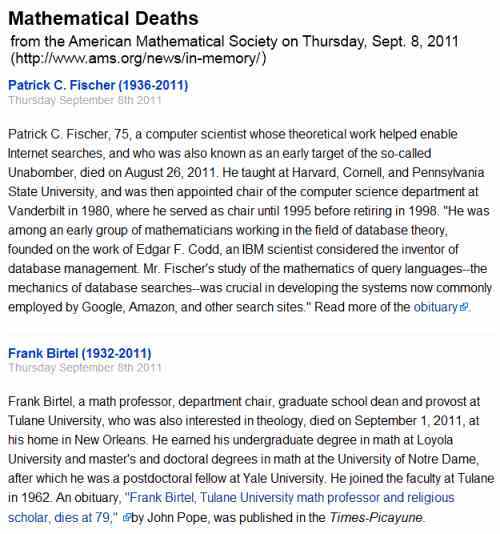
For Fischer's fellow database enthusiast Codd, see Cross-Referenced (April 24, 2003).
For Birtel's fellow pseudoscience enthusiast Frank Tipler, see the artist's comment linked to in Romancing the Omega (April 19, 2011)—
"Omega Point" is a term used by mathematical physicist Frank Tipler for what he maintains is the ultimate fate of the universe required by the laws of physics."
Saturday, August 6, 2011
Norway Summer
(Continued from June 21)
Footnote to a new web page from the European Culture Congress—
Photo credit: Josefine Lyche, “The 2×2 Case (Diamond Theorem)
after Steven H. Cullinane”, 450 x 650 cm,
Tromsø Kunstforening, 2010, image courtesy: the artist.
Thursday, August 4, 2011
Midnight in Oslo
For Norway's Niels Henrik Abel (1802-1829)
on his birthday, August Fifth
(6 PM Aug. 4, Eastern Time, is 12 AM Aug. 5 in Oslo.)
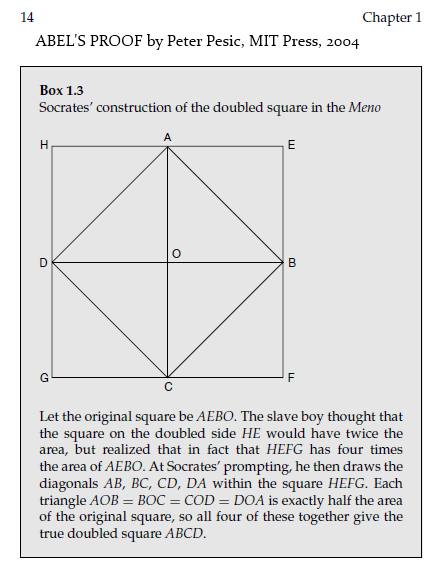
Plato's Diamond
The above version by Peter Pesic is from Chapter I of his book Abel's Proof , titled "The Scandal of the Irrational." Plato's diamond also occurs in a much later mathematical story that might be called "The Scandal of the Noncontinuous." The story—
Paradigms"These passages suggest that the Form is a character or set of characters common to a number of things, i.e. the feature in reality which corresponds to a general word. But Plato also uses language which suggests not only that the forms exist separately (χωριστά ) from all the particulars, but also that each form is a peculiarly accurate or good particular of its own kind, i.e. the standard particular of the kind in question or the model (παράδειγμα ) [i.e. paradigm ] to which other particulars approximate…. … Both in the Republic and in the Sophist there is a strong suggestion that correct thinking is following out the connexions between Forms. The model is mathematical thinking, e.g. the proof given in the Meno that the square on the diagonal is double the original square in area." – William and Martha Kneale, The Development of Logic , Oxford University Press paperback, 1985 Plato's paradigm in the Meno—
Changed paradigm in the diamond theorem (2×2 case) —
Aspects of the paradigm change— Monochrome figures to Areas to Continuous transformations to Euclidean geometry to Euclidean quantities to The 24 patterns resulting from the paradigm change—
Each pattern has some ordinary or color-interchange symmetry. This is the 2×2 case of a more general result. The patterns become more interesting in the 4×4 case. For their relationship to finite geometry and finite fields, see the diamond theorem. |
Related material: Plato's Diamond by Oslo artist Josefine Lyche.
“Plato’s Ghost evokes Yeats’s lament that any claim to worldly perfection inevitably is proven wrong by the philosopher’s ghost….”
— Princeton University Press on Plato’s Ghost: The Modernist Transformation of Mathematics (by Jeremy Gray, September 2008)
"Remember me to her."
— Closing words of the Algis Budrys novel Rogue Moon .
Background— Some posts in this journal related to Abel or to random thoughts from his birthday.
Friday, July 8, 2011
Baudelaire, Your Shiny Friend
Google Translate version of a recent Norwegian art review—
Josefine Lyche show is working on the basis of crop circles occur in Pewsey, Wiltshire in England for exactly one year ago on 21 June. Three circulars forms of aluminum quote forms from the field in England. With this as a starting point invites Lyche viewer to explore the sacred shapes and patterns through painting, floor work and sculpture. In the monumental painting "Wisdom Luxury Romance" draws Lyche lines to both Matisse and Baudelaire in his poem
From the artist's website, JosefineLyche.com—
WISDOM LUXURY ROMANCE
From elsewhere—

Related material—
From Antichristmas 2002— Aluminum, Your Shiny Friend.
From Sept. 22, 2004— Tribute… in the context of
today's previous entry and of the conclusion of the story
that later became Childhood's End —

Tuesday, June 21, 2011
Sunday, May 22, 2011
Asterisk*
A year ago today—
Art Space
|
Pictorial version |
|
| “Space: what you damn well have to see.” – James Joyce, Ulysses |
|

* See Vonnegut.
Thursday, May 5, 2011
On Art and Magic
Two Blocks Short of a Design:
A sequel to this morning’s post on Douglas Hofstadter

Photo of Hofstadter by Mike McGrath taken May 13, 2006 |
Related material — See Lyche’s “Theme and Variations” in this journal
and Hofstadter’s “Variations on a Theme as the Essence of Imagination”
— Scientific American October 1982
A quotation from a 1985 book by Hofstadter—
“… we need to entice people with the beauties of clarity, simplicity, precision,
elegance, balance, symmetry, and so on.
Those artistic qualities… are the things that I have tried to explore and even
to celebrate in Metamagical Themas . (It is not for nothing that the word
‘magic’ appears inside the title!)”
The artistic qualities Hofstadter lists are best sought in mathematics, not in magic.
An example from Wikipedia —
|
Mathematics
The Fano plane block design |
Magic
The Deathly Hallows symbol— |
Wednesday, April 20, 2011
ART WARS continued
Part I— A Naples, Florida obituary for artist Robert Vickrey, who died Sunday.
(See also this evening's earlier post Soul Art.)
Part II— "Stairway to Heaven," by Vickrey
Part III— Definition of "cornette"
Part IV— Recent photo of artist Josefine Lyche
Tuesday, April 19, 2011
Romancing the Omega
Today's news from Oslo suggests a review—
The circular sculpture in the foreground
is called by the artist "The Omega Point."
This has been described as
"a portal that leads in or out of time and space."
Some related philosophical remarks—
Friday, March 11, 2011
Now Lens
A Story in Pictures
Errol Morris in The New York Times on March 9—
"If everything is incommensurable, then everything is seen through the lens of the present, the lens of now ."
"Borges concluded by quoting Chesterton, 'there is nothing more frightening than a labyrinth that has no center.' [72]"






Thursday, February 24, 2011
Now Lens (continued)
"…the farther back we manage to wiggle
the more we need the loan of a lens…." —Finnegans Wake
For some background on the lens below, see the sermon on February 20th, 2011.
“The quad gospellers may own the targum but any of the Zingari shoolerim
may pick a peck of kindlings yet from the sack of auld hensyne.”
The above "Zingari shoolerim" passage was quoted here in Frame Tales (November 10th, 2008).
That post concerned the Heinrich Zimmer tale "The King and the Corpse." Some related material—

Sunday, February 20, 2011
Sermon
From Galleri MGM in Oslo —
A connection to today's earlier post, Sunday School— The Oslo Version, from Friday, May 21, 2010.
Lyche's "Omega Point" portal, together with her last name, suggested three posts from the following Saturday morning— which later proved to be the date of Martin Gardner's death—
Art Space, Through the Lyche Gate and The Lyche Gate Asterisk.
For some further religious remarks, see November 9th, 2010— A Theory of Pure Design.
Friday, February 11, 2011
Omega*
And I'd like to thank the heroine of Finale —
* The title refers to a 2009 sculpture by Lyche —
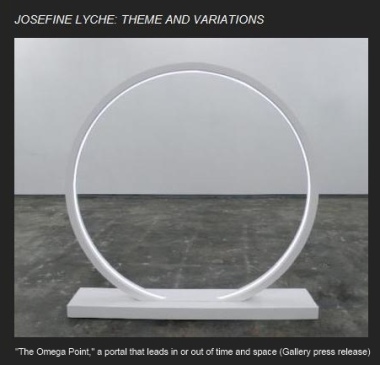
For a related shape, see today's noon post.
Wednesday, December 15, 2010
Punch
David Corfield discusses the philosophy of mathematics (Dec. 14) —
"It’s very tricky choosing a rich and interesting case study which is philosophically salient. To encourage the reader or listener to follow up the mathematics to understand what you’re saying, there must be a decent pay-off. An intricate twentieth century case study had better pack plenty of meta-mathematical punch."
Steve Martin discusses the philosophy of art (Dec. 5) —
 |
 |
CBS News interviews Martin at the Whitney Museum —
"We paused to consider the impact of a George Bellows fight scene. Martin said it has 'wall power.'
What does that phrase mean? 'How it holds the wall. How it feels when you're ten or 20 feet away from it. It really takes hold of the room.'"
See also Halloween 2010 —
Tuesday, November 9, 2010
Design
A Theory of Pure Design
by Denman Waldo Ross
Lecturer on the Theory of Design
in Harvard University
Boston and New York
Houghton, Mifflin and Company, 1907
PREFACE
"My purpose in this book is to elucidate, so far as I can, the
principles which underlie the practice of drawing and painting
as a Fine Art. Art is generally regarded as the expression of
feelings and emotions which have no explanation except per-
haps in such a word as inspiration , which is expletive rather
than explanatory. Art is regarded as the one activity of man
which has no scientific basis, and the appreciation of Art is
said to be a matter of taste in which no two persons can be
expected to agree. It is my purpose in this book to show how,
in the practice of Art, as in all other practices, we use certain
terms and follow certain principles. Being defined and ex-
plained, these terms and principles may be known and under-
stood by everybody. They are, so to speak, the form of the
language.
While an understanding of the terms and principles of Art
will not, in itself, enable any one to produce important works,
such works are not produced without it. It must be understood,
however, that the understanding of terms and principles
is not, necessarily, an understanding in words. It may lie in
technical processes and in visual images and may never rise,
or shall I say fall, to any formulation in words, either spoken
or written."
_________________________________________________
One of Ross's protégés, Jack Levine, died yesterday at 95. He
is said to have remarked, "I want to paint with the dead ones."
Related material: This journal on the day of Levine's death
and on the day of Martin Gardner's death.
The latter post has an image illustrating Ross's remarks on
formulations in words—

For further details, see Finale, Darkness Visible, and Packed.
Tuesday, November 2, 2010
A Dozen Pairs of Opposites —
24 graphic patterns arranged in space
as 12 pairs of opposites
Click image for an illustration of how the above labeling was derived.
For further background, see Cases of the Diamond Theorem
and recent art by Josefine Lyche of Norway.
Sunday, October 31, 2010
Diamond Theorem in Norway
Thursday, July 15, 2010
Brightness at Noon, continued
"What exactly was Point Omega?"
This is Robert Wright in Nonzero: The Logic of Human Destiny.
Wright is discussing not the novel Point Omega by Don DeLillo,
but rather a (related) concept of the Jesuit philosopher Pierre Teilhard de Chardin.
My own idiosyncratic version of a personal "point omega"—
The circular sculpture in the foreground
is called by the artist "The Omega Point."
This has been described as
"a portal that leads in or out of time and space."
For some other sorts of points, see the drawings
on the wall and Geometry Simplified—

The two points of the trivial affine space are represented by squares,
and the one point of the trivial projective space is represented by
a line segment separating the affine-space squares.
For related darkness at noon, see Derrida on différance
as a version of Plato's khôra—
The above excerpts are from a work on and by Derrida
published in 1997 by Fordham University,
a Jesuit institution— Deconstruction in a Nutshell—
For an alternative to the Villanova view of Derrida,
see Angels in the Architecture.
Thursday, July 1, 2010
Omega at Eight
The "compact key to universal wisdom" passage in the previous post seemed
too well written to be the work of an anonymous webforum author.
Here is a slightly expanded version—
Throughout history mystics and philosophers have sought
a compact key to universal wisdom, a finite formula or text
that would provide the answer to every question. The use of
the Bible, the Koran and the I Ching for divination and the
tradition of the secret books of Hermes Trismegistus and the
medieval Jewish Cabala exemplify this belief or hope. Such
sources of universal wisdom are traditionally protected from
casual use by being difficult to find as well as difficult to un-
derstand and dangerous to use, tending to answer more quest-
ions and deeper ones than the searcher wishes to ask. The
esoteric book is, like God, simple yet undescribable. It is om-
niscient, and it transforms all who know it. The use of clas-
sical texts to foretell mundane events is considered supersti-
tious nowadays, yet in another sense science is in quest of its
own Cabala, a concise set of natural laws that would explain
all phenomena. In mathematics, where no set of axioms can
hope to prove all true statements, the goal might be a concise
axiomatization of all "interesting" true statements.
Ω is in many senses a Cabalistic number. It can be known
of through human reason, but not known. To know it in detail
one must accept its uncomputable sequence of digits on faith,
like words of a sacred text.
This is Martin Gardner's* and Charles H. Bennett's
revised version of a passage from Bennett's paper
"On Random and Hard-to-Describe Numbers," 1979.
The original passage from Bennett's paper—
Throughout history mystics and philosophers have sought a compact key to
universal wisdom, a finite formula or text which, when known and understood,
would provide the answer to every question. The Bible, the Koran, the mythical
secret books of Hermes Trismegistus, and the medieval Jewish Cabala have
been so regarded. Sources of universal wisdom are traditionally protected from
casual use by being hard to find, hard to understand when found, and dangerous
to use, tending to answer more and deeper questions than the user wishes to
ask. Like God the esoteric book is simple yet undescribable, omniscient, and
transforms all who know It. The use of classical texts to fortell [sic] mundane events
is considered superstitious nowadays, yet, in another sense, science is in quest of
its own Cabala, a concise set of natural laws which would explain all phenomena.
In mathematics, where no set of axioms can hope to prove all true statements,
the goal might be a concise axiomatization of all "interesting" true statements.
Ω is in many senses a Cabalistic number. It can be known of, but not known,
through human reason. To know it in detail, one would have to accept its un-
computable digit sequence on faith, like words of a sacred text.
The Bennett paper deals with Gregory Chaitin's concept of an "Omega Number."
I prefer the Omega of Josefine Lyche—
See also All Hallows' Eve, 2002.
* Martin Gardner's Mathematical Games column
"The Random Number Omega Bids Fair to Hold the Mysteries of the Universe,"
Scientific American, November 1979, 241(5), pp. 20–34.
The column is reprinted as "Chaitin's Omega," Ch. 21, pp. 307-319 in the
collection of Gardner's columns titled Fractal Music, Hypercards and More,
W.H. Freeman & Co., 1991
Tuesday, June 15, 2010
Imago, Imago, Imago
Recommended— an online book—
Flight from Eden: The Origins of Modern Literary Criticism and Theory,
by Steven Cassedy, U. of California Press, 1990.
See in particular
Valéry and the Discourse On His Method.
Pages 156-157—
Valéry saw the mind as essentially a relational system whose operation he attempted to describe in the language of group mathematics. "Every act of understanding is based on a group," he says (C, 1:331). "My specialty—reducing everything to the study of a system closed on itself and finite" (C, 19: 645). The transformation model came into play, too. At each moment of mental life the mind is like a group, or relational system, but since mental life is continuous over time, one "group" undergoes a "transformation" and becomes a different group in the next moment. If the mind is constantly being transformed, how do we account for the continuity of the self? Simple; by invoking the notion of the invariant. And so we find passages like this one: "The S[elf] is invariant, origin, locus or field, it's a functional property of consciousness" (C, 15:170 [2: 315]). Just as in transformational geometry, something remains fixed in all the projective transformations of the mind's momentary systems, and that something is the Self (le Moi, or just M, as Valéry notates it so that it will look like an algebraic variable). Transformation theory is all over the place. "Mathematical science . . . reduced to algebra, that is, to the analysis of the transformations of a purely differential being made up of homogeneous elements, is the most faithful document of the properties of grouping, disjunction, and variation in the mind" (O, 1:36). "Psychology is a theory of transformations, we just need to isolate the invariants and the groups" (C, 1:915). "Man is a system that transforms itself" (C, 2:896).
O Paul Valéry, Oeuvres (Paris: Pléiade, 1957-60)
C Valéry, Cahiers, 29 vols. (Paris: Centre National de le Recherche Scientifique, 1957-61)
Compare Jung's image in Aion of the Self as a four-diamond figure:

and Cullinane's purely geometric four-diamond figure:

For a natural group of 322,560 transformations acting on the latter figure, see the diamond theorem.
What remains fixed (globally, not pointwise) under these transformations is the system of points and hyperplanes from the diamond theorem. This system was depicted by artist Josefine Lyche in her installation "Theme and Variations" in Oslo in 2009. Lyche titled this part of her installation "The Smallest Perfect Universe," a phrase used earlier by Burkard Polster to describe the projective 3-space PG(3,2) that contains these points (at right below) and hyperplanes (at left below).
Although the system of points (at right above) and hyperplanes (at left above) exemplifies Valéry's notion of invariant, it seems unlikely to be the sort of thing he had in mind as an image of the Self.
Tuesday, June 1, 2010
Annals of Art History
On Misplaced Concreteness—
An excerpt from China and Vietnam: The Politics of Asymmetry, by Brantly Womack (Cambridge U. Press, 2006)—
The book is intended to be a contribution to the general theory of international relations as well as to the understanding of China and Vietnam, but I give greater priority to “the case” rather than to the theory. This is a deliberate methodological decision. As John Gerring has argued, case studies are especially appropriate when exploring new causal mechanisms.2 I would argue more broadly that the “case” is the reality to which the theory is secondary. In international relations theory, “realism” is often contrasted to “idealism,” but surely a more basic and appropriate meaning of “realism” is to give priority to reality rather than to theory. The philosopher Alfred North Whitehead defined the Fallacy of Misplaced Concreteness as “neglecting the degree of abstraction involved when an actual entity is considered merely so far as it exemplifies certain categories of thought.”3 In effect, the concept is taken as the concrete reality, and actual reality is reduced to a mere appendage of data. Misplaced Concreteness may well be the cardinal sin of modern social science. It is certainly pandemic in international relations theory, where a serious consideration of the complexities of real political situations is often dismissed as mere “area studies.” Like the Greek god Anteus who was sustained by touching his Mother Earth, theory is challenged and rejuvenated by planting its feet in thick reality.
2 John Gerring, "What Is a Case Study and What Is It Good For?"
American Political Science Review 98:2 (May 2004), pp. 341-54
3 Alfred North Whitehead, Process and Reality
(New York: Harper, 1929), p. 11
Remarks—
"Whitehead defined the Fallacy of Misplaced Concreteness…."
The phrase "misplaced concreteness" occurs in the title of a part of an exhibition, "Theme and Variations," by artist Josefine Lyche (Oslo, 2009). I do not know what Lyche had in mind when she used the phrase. A search for possible meanings yielded the above passage.
"In international relations theory, “realism” is often contrasted to “idealism….”
For a more poetic look at "realism" and "idealism" and international relations theory, see Midsummer Eve's Dream.
Sunday, May 30, 2010
Trilateral

"Greater East Asia" (大東亜 Dai-tō-a)
was a Japanese term
(banned during the post-war Occupation)
referring to Far East Asia. —Wikipedia

Related historical remarks from Wikipedia—
"From the Japanese point of view, one common principal reason stood behind both forming the Greater East Asia Co-Prosperity Sphere and initiating war with the Allies: Chinese markets. Japan wanted their 'paramount relations' in regard to Chinese markets acknowledged by the U.S. government. The U.S., recognizing the abundance of potential wealth in these markets, refused to let the Japanese have an advantage in selling to China."
"Shine on, shine on,
there is work to be done
in the dark before the dawn."

"The exhibition title Theme and Variations
hints at the analytical-intellectual undertone
Josefine Lyche takes this time, but
not without humorous touches."
Friday, May 28, 2010
Multispeech
For Memorial Day Weekend:
See also Time and Chance: Log24 Posts of Oct. 24, 2006*, which include a link to the work of Msgr.✝ Robert Sokolowski of the Catholic University of America.
* For the connection between Finnegans Wake and the date October 24, 2006, see Polyglot Joyce, p. 223, and Phrase Finder.
✝ From the posts of Saturday, May 22— "The Lyche Gate was the covered gateway at the entrance of the church yard, where the corpse was rested until the priest issued from the church to meet the procession."
— Ancient English Ecclesiastical Architecture, by Frank Wills, published by Stanford and Swords, 1850
Tuesday, May 25, 2010
Sisteen
"Nuvoletta in her lightdress, spunn of sisteen shimmers,
was looking down on them, leaning over the bannistars….
Fuvver, that Skand, he was up in Norwood's sokaparlour…."
— Finnegans Wake
To counteract the darkness of today's 2:01 AM entry—
Part I— Artist Josefine Lyche describes her methods—
A— "Internet and hard work"
B— "Books, both fiction and theory"
Part II— I, too, now rely mostly on the Internet for material. However, like Lyche, I have Plan B— books.
Where I happen to be now, there are piles of them. Here is the pile nearest to hand, from top to bottom.
(The books are in no particular order, and put in the same pile for no particular reason.)
- Philip Rieff— Sacred Order/Social Order, Vol. I: My Life Among the Deathworks
- Dennis L. Weeks— Steps Toward Salvation: An Examination of Coinherence and Substitution in the Seven Novels of Charles Williams
- Erwin Panofsky— Idea: A Concept in Art Theory
- Max Picard— The World of Silence
- Walter J. Ong, S. J.— Hopkins, the Self, and God
- Richard Robinson— Definition
- X. J. Kennedy and Dana Gioia, eds.— An Introduction to Poetry
- Richard J. Trudeau— The Non-Euclidean Revolution
- William T. Noon, S. J.— Joyce and Aquinas
- Munro Leaf— Four-and-Twenty Watchbirds
- Jane Scovell— Oona: Living in the Shadows
- Charles Williams— The Figure of Beatrice
- Francis L. Fennell, ed.— The Fine Delight: Centenary Essays on the Poetry of Gerard Manley Hopkins
- Hilary Putnam— Renewing Philosophy
- Paul Tillich— On the Boundary
- C. S. Lewis— George MacDonald
Lyche probably could easily make her own list of what Joyce might call "sisteen shimmers."
Monday, May 24, 2010
Finale
The weekend's posts in this journal coincided,
more or less, with the finale of the TV series "Lost."
Recalling each story brings to mind
the subtitle of Heinrich Zimmer's classic
The King and the Corpse —
Tales of the Soul's Conquest of Evil.
Here, in the spirit of "The Fifth Element," is a
brief graphic summary of such a conquest—
The Soul
Evil
(from Saturday morning)

Sunday, May 23, 2010
For Your Consideration —
Cannes Festival Readies for Awards Night
Uncertified Copy
The pictures in the detail are copies of
figures created by S. H. Cullinane in 1986.
They illustrate his model of hyperplanes
and points in the finite projective space
known as PG(3,2) that underlies
Cullinane's diamond theorem.
The title of the pictures in the detail
is that of a film by Burkard Polster
that portrays a rival model of PG(3,2).
The artist credits neither Cullinane nor Polster.
Annals of Philosophy
Annals of Conceptual Art
Josefine Lyche's
"Theme and Variations" (Oslo, 2009)—
Some images in reply—
Frame Tale
Click on images for further details.
"In the name of the former
and of the latter
and of their holocaust.
Allmen."
Saturday, May 22, 2010
In the Details
Today's New York Times—
|
"…there were fresh questions about whether the intelligence overhaul that created the post of national intelligence director was fatally flawed, and whether Mr. Obama would move gradually to further weaken the authorities granted to the director and give additional power to individual spy agencies like the . Mr. Blair and each of his predecessors have lamented openly that the intelligence director does not have enough power to deliver the intended shock therapy to America’s byzantine spying apparatus." |
Catch-22 in Doonesbury today—

From Log24 on Jan. 5, 2010—
Artifice of Eternity—
A Medal
In memory of Byzantine scholar Ihor Sevcenko,
who died at 87 on St. Stephen's Day, 2009–
Thie above image results from a Byzantine
meditation based on a detail in the previous post—

"This might be a good time to
call it a day." –Today's Doonesbury
"TOMORROW ALWAYS BELONGS TO US"
Title of an exhibition by young Nordic artists
in Sweden during the summer of 2008.
The exhibition included, notably, Josefine Lyche.





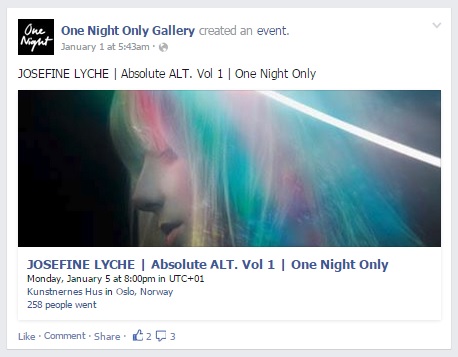





























 .
.






 .
.































